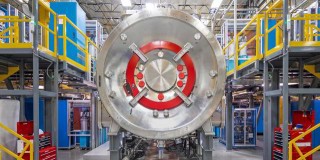Loading
Search
▼ '100,000 Years Of Power' | US-Japan Team Hails H2-Boron Plasma Fusion Breakthrough
- Category:Other
California-based TAE Technologies and Japan’s National Institute for Fusion Science claim success testing new fuel cycle, opening door to cleaner, lower cost energy than produced by conventional deuterium-tritium-based process
An innovative nuclear fusion technology that uses no radioactive materials and is calculated capable of “powering the planet for more than 100,000 years”, has been successfully piloted by a US-Japanese team of researchers.
California-based TAE Technologies, working with Japan’s National Institute for Fusion Science (NIFS), have completed first tests of a hydrogen-boron fuel cycle in magnetically-confined plasma, which could generate cleaner, lower cost energy that that produced by the more common deuterium-tritium (D-T) fusion process.
“This experiment offers us a wealth of data to work with and shows that hydrogen-boron has a place in utility-scale fusion power.
We know we can solve the physics challenge at hand and deliver a transformational new form of carbon-free energy to the world that relies on this non-radioactive, abundant fuel,” said Michl Binderbauer, CEO of TAE Technologies.
A spokesperson for NIFS, which formed its partnership with TAE in 2021, noted: “Hydrogen-boron… enables the concept of cleaner fusion reactors – this achievement is a big first step towards the realisation of a fusion reactor using advanced fusion fuel.”
The experiments were carried out in NIFS’ large helical device, known as a stellarator, but TAE is developing a so-called field-reversed configuration reactor that promises “a variety of benefits over stellarator and tokamak reactors, including having a compact footprint and more efficient magnetic confinement that will yield up to 100 times more power output, according to the scientists, who published their findings today in the journal Nature.
“Inventing fusion reactors that produce net energy is one thing, delivering it as a reliable, grid-ready source of electricity is another. By choosing to pursue hydrogen-boron as a fuel cycle, TAE has anticipated the true demands of commercial, daily use of fusion energy.
“Most fusion efforts around the world are focused on combining DT hydrogen isotopes to use as fuel, and the donut-shaped tokamak machines commonly used are limited to DT fuel.
Unlike those efforts, [our] design uses an advanced accelerator beam-driven field-reversed configuration that is versatile, and can accommodate all available fusion fuel cycles.”
This fuel-agnostic reactor design, which features a sensor able to detect helium nuclei alpha particles– the only emissions from H2-boron fusion, is expected to make it possible for TAE to license its technology “on the way to its ultimate goal” of connecting the first hydrogen-boron fusion power plant to the grid in the 2030s.
More than 30 research groups around the world are racing to commercialise fusion, seen as the “perfect power” source as the planet shifts away from the CO2 emitting fossil fuels that are contributing heavily to global heating
TAE highlighted that it had built five “national laboratory-scale” devices – with which it had generated and confined fusion plasma “more than 140,000 times” – and is currently building two further machines, dubbed Copernicus and Da Vinci, with a view to “demonstrating net energy and deliver power to the grid, respectively”.
US researchers at the US National Ignition Facility in California in December hailed fusion experiments that had achieved “ignition gain or energy gain”, where the energy released was greater than was pumped in the high-powered lasers used in the fusion process.
- March 2, 2023
- Comment (0)
- Trackback(0)


